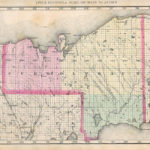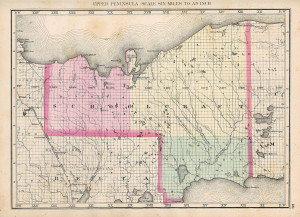Schoolcraft county was organized in 1876. It is bounded on the north by Lake Superior, on the east by Chippewa and Mackinac, on the south by Delta and Lake Michigan, on the west by Delta and Marquette. It is the fourth county in the State in size, and has an area of 2,196 square miles. Manistique, a growing town of 700 inhabitants, situated in the southern portion of the county on Lake Michigan, is the county seat. The northern and northwestern portions of the county are heavily timbered with white pine of good quality, growing on land also heavily timbered with maple, birch, and bass wood. The soil in this section is a sandy loam. The middle and western part comprises what is known as the Manistique flats—lands generally level, but with a descent to the southeast sufficient for drainage. Those lands have been largely overflowed, occasioned by beaver dams in the numerous streams or branches of the Manistique. The soil is a vegetable deposit or muck with a subsoil of marl, clay, and sand, underlaid with lime rock. Large marshes are interspersed with grass of the finest quality. The timber is principally pine on the ridges, and spruce, cedar, etc., near the rivers. The eastern and southern portions are more rolling and timbered with hardwood maple, birch, basswood, and elm on the highlands, and cedar, pine, and hemlock on the lower lands. The soil is a dark sand loam on lime rock and clay, and is a very desirable agricultural region. Homestead entries are numerous and the settlers prosperous. This portion embraces a portion of the Manistique lake region.
George F. Fuller Post, No. 257 – Manistique, MI
The George F. Fuller Post, No. 257 – Grand Army of The Republic
The Fuller Grand Army of the Republic Post was organized in Schoolcraft County on June 16th, 1884. This fraternity was open to honorably discharged veterans who had served in the Union Army during the American Civil War (1861-1865). The G.A.R. post in Manistique was named after George F. Fuller. Mr. Fuller served with the 45th Pennsylvania Infantry and was enlisted into Co. E as a Private on November 13, 1864. He was discharged on July 17, 1865 at Alexandria, Virginia. Mr. Fuller moved to Michigan with his family after the war and eventually settled in Schoolcraft County. He died in 1875. At the time of the organization of the Fuller GAR post, Mr. Fuller was the only soldier buried in the Lakeview Cemetery.
The Flood Of 1920-Palm Sunday
The Flood Of 1920-Palm Sunday (March 28th, 1920) Manistique, MI-The most catastrophic event to occur in Manistique other than the fire of 1883 was the flood of 1920. Floodwaters began pouring over the flume walls in the early morning of Palm Sunday, March 28, 1920. The immediate cause of the flood was an ice jam on the Driggs River that backed the river up. When the jam broke, the water and logs in the river rushed into the Manistique River. Since the winter had an exceptional snowfall along with warmer than normal temperatures and several days of rain, the rivers draining into the Manistique River were already swollen. With the torrent of water, a west bank wall broke, causing water to rush over the flume walls and into the west side of Manistique all the way down Deer Street and Chippewa Avenue.
The Christmas Tree Ships
Chicago may not have an ocean, but we do have Lake Michigan. We are a maritime city. This is one day to remember that tradition, with the story of the Christmas Tree ships.
Around the turn of the 20th Century, the German custom of decorating Christmas trees was taking hold in Chicago. The closest evergreen forests were in northern Wisconsin and upper Michigan.
Each November a few lake schooners loaded up with trees and sailed them down to Chicago. Customers would come over to the Clark Street dock, go aboard a ship, and select their tree. It was fun way for city families to get into the holiday spirit.



